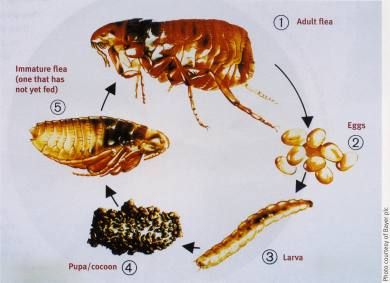Cluster Flies – A Nuisance Handled by Pest Detective & Discover More about a Flea’s Life Cycle
Cluster Flies
The cluster fly (Pollenia rudis), of which there are many different types, can be found throughout the UK, Europe and various other parts of the world.
Cluster flies are not associated with poor hygiene, they are not thought to carry diseases and they do not represent a health hazard to humans as they do not lay their eggs in human food. Cluster flies prefer earthworms instead. The female cluster fly will lay her eggs near where earthworms burrow, either in the soil or on dead and rotting leaves, and then when the eggs hatch, the larvae or maggots will seek out earthworms and feed on them until they are fully grown. So if cluster flies are not harmful to humans, why should they pose a problem?
Cluster flies are generally outdoor flies, but when the weather becomes cooler, in late autumn and winter for example, they will often decide to move indoors, sometimes in their thousands, and can be found hibernating in buildings or attics, hence the reason they are often referred to as “attic flies.” They favour inaccessible places such as inside the walls, inside cracks and cavities near the ceiling, or around windows, or in basements, lofts or any other rooms that are not used very often. When the weather warms up a bit, they may start flying around, and anyone who has ever experienced an infestation of cluster flies will tell you this is not a pleasant experience.
Houses and buildings that are in the countryside can be more at risk of attracting cluster flies due to the simple fact that there are fewer places for the adult flies to find shelter. You are also more likely to find cluster flies in buildings that are situated near to where earthworms are present, such as areas of turf or grass, gardens, cemeteries, pastures, parks and fields.
How to Recognize a Cluster Fly
Cluster flies look very similar to the common housefly although they are slightly larger in size and can be identified by physical markings such as the yellowy golden coloured hairs on the thorax (the part that lies between the head and the stomach or in insects, the point where the legs and the wings attach to the body) and by the different shades of gray across the abdomen. They also move more lethargically than the common housefly.
How to Get Rid of Cluster Flies
An infestation of cluster flies is not only upsetting for the occupants, they are also a nuisance, and not just because the flies are usually present in such frighteningly large numbers, but also because they can be quite difficult to get rid of. This is mainly due to the fact that they can be hibernating in places that are not so easy to reach.
However, if and when they start flying around, then all these visible flies can quite easily be dealt with by a good domestic insecticidal aerosol spray which will be effective and highly efficient at getting rid of them. You can simply vacuum up flies that are already dead or are moving slowly, but make sure you empty the vacuum cleaner outside in a sealed bag.
For flies that are hibernating inside walls or in other inaccessible places, then you may need some professional advice either from the environmental health department or from an expert in pest control in order to eliminate them from the premises entirely.
Bearing in mind the difficulties associated with getting rid of cluster flies once they have ventured indoors, it may be prudent to take steps to help prevent them from entering buildings in the first place. You can make sure that all roofs and windows are properly sealed, slates or tiles are replaced, and cracks or crevices are promptly repaired, particularly before late autumn when the flies will start looking for shelter.
Unfortunately, despite the best efforts, nothing is 100% effective at stopping them from coming inside as cluster flies are adept at finding tiny openings in which to crawl through. This is particularly bad news for some people because interestingly enough, and no one knows why, cluster flies will often choose to return to exactly the same place to shelter year after year even though there may be other more accessible buildings nearby.
A Flea’s Life Cycle
The Pest Detective often removes pests like fleas and ticks from homes. If you are a pet owner, fleas have a better chance of accessing your property. On this page you will find a small diagram explaining the life cycle of your average flea. The flea grows through five stages:
- Egg
- Larva
- Pupa
- Immature flea (not yet fed)
- Adult flea

To learn more about our individual locations, please click on the locations below:
Pest Detective Pest Control Locations
Find your nearest pest control specialist
